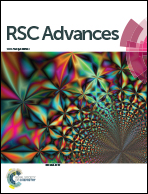4-Oxo- or 1-oxo-N7O+? A computational and experimental study†
Abstract
In a previous paper [Inorg. Chem., 2010, 49, 1245], we studied the reaction of F2NO+ with an excess of HN3 which led to the quantitative formation of N5+ and N2O. Based on 15N-labeling experiments and theoretical calculations, the formation of a 4-oxo-N7O+ intermediate with a decomposition energy barrier of about 40 kcal mol−1 was proposed. Since this relatively high barrier disagreed with our failure to experimentally observe this cation, a thorough theoretical study of the isomerization, dissociation and formation pathways of N4FO+ and N7O+ was carried out at the B3LYP and G3B3 levels at 240 K. It was found that the self-decomposition of 4-oxo-N7O+ to NO+ and N2 has a considerably lower barrier of only 19.6 kcal mol−1 and, therefore, would be more likely than a self-decomposition to N5+ and N2O. Additional calculations also showed that alternate reaction pathways between the stable and well-characterized z-N4FO+ intermediate product and HN3 involving 7- or 9-membered cyclic transition states, can lead to the observed N5+ and N2O products with the observed 15N distribution and barriers as low as 20.7 kcal mol−1. The transition states for these reactions contain a 1-oxo-N7O+ component which can decompose without a barrier to N5+ and N2O. These alternative pathways involving an unstable 1-oxo-N7O+ cation are in better agreement with experiment than the one involving 4-oxo-N7O+. The correctness of this re-interpretation was experimentally verified by a 15N-labeling experiment between α- and γ-15N-labeled HN3 and unlabeled N4FO+ which resulted exclusively in unlabeled N2O and α- and γ-15N-labeled N5+. Therefore, we conclude that in the reaction of NF2O+ with excess HN3 the experimental and theoretical evidence supports only the formation of an unstable 1-oxo-N7O+ cation, and that for the preparation of the symmetric 4-oxo-N7O+ cation different synthetic approaches will be required.


 Please wait while we load your content...
Please wait while we load your content...